colour Capsicum cultivation Process
Capsicum is an important commercial vegetable crop known as sweet pepper, bell pepper, or Shimla Mirch. These plants grew throughout the world.
This crop is a cold season crop, but capsicum is cultivated throughout the year using polyhouse.
Capsicum is a rich source of vitamin A, vitamin C, and mineral calcium (13.4 mg), magnesium (14.9 mg) of phosphorus (28.3 mg), of potassium (263.7 mg) per 100 grams of fresh capsicum fruit weight.
Soil texture required for capsicum cultivation
The selection of soil is an important decision. Soil selection for capsicum cultivation following points should be considered:
- The pH of the soil should be between 6.0 to 6.5
- The soil’s salinity level should not be more than 1 ms/cm; therefore, as soon as you select the site, analyze the soil for further improvement.
- The soil should be highly porous and should be well-drained so that the roots can be improved and the better penetration of the roots.
Bed preparation for capsicum cultivation
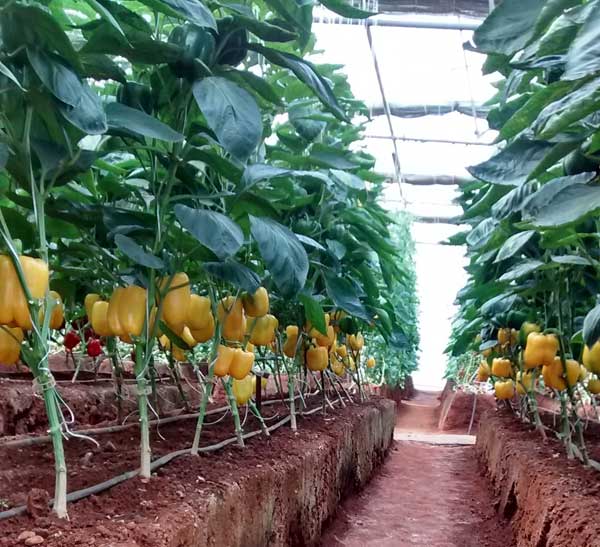
- Height: 1 foot (30 centimeters)
- width: 3 feet (90 centimeters)
- Between beds: 2 feet (60 centimeters)
Capsicum Cultivation Transplanting
Plant transplant in soil without disturbing the root ball. two rows planted on a single bed
- plant to plant distance 45 to 50 cm
- row to row distance 50 cm
After plantation, maintain moisture 80-90% For the protection of plants, from 2 to 3 weeks.
Capsicum cultivation Pruning
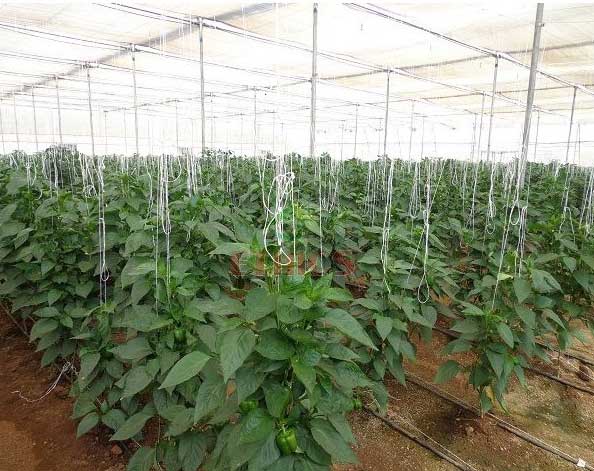
Capsicum plants are cut to maintain four stems. The plant’s tip is divided into two on the 5 or 6 nodes and left to grow. These two branches have again increased in two branches.
The tip on each node is divided by giving a strong branch and one weak branch. Pruning is done after 30 days at an interval of 8 to 10 days, resulting in bigger fruits with better quality and higher productivity.
Capsicum plants can also be harvested for two stems, and the same level of yield can be maintained.

Irrigation
To reduce the pH of water, add the acid to the water tank, then use water for irrigation and sprinkling.
- Immediately after plantation, irrigation required to start the first shower is required to use after some days drip irrigation use this will help for uniform root development of a plant,
- Usually, a dripper per plant is required. Depending on the season, drip irrigation provides 2-4 liters of water per square meter. In hot summer, a fogger can be used to maintain the air humidity.
- Inspect the soil column for irrigation and visually check the soil moisture content. After this, determine the amount of irrigation required.
- During the summer season, apply water to the edges of the bed repeatedly by using the shower to reduce the evaporator’s loss. For this purpose, provision for a water outlet (1 “diameter pipe) inside the Greenhouse should be made.
- Always pour the plant water from noon.
- Relative humidity of air should not be more than 90 – 92 percent because it is inclined to disturb the fruit.
- Always use fresh water for irrigation. Do not store water for 4 to 5 days.
Fertigation for capsicum cultivation
- Fertigation is applicable after three weeks of vegetation phase N: P: K: 1: 1: 1 (e.g., 19: 19: 19 ) at 0.4 g During the vegetation phase, preferably for every 45-60 alternate days with for better leaves
- After 60 days start, N: P: K 2: 1: 4 (e.g., N: P: k: 15: 8: 35) at 0.4 g / 2.2 ms/cm more flower and better fruit quality with each alternate day EC.
- Fertilization and yield often in small quantities for optimal results. However, always take care to meet the crop requirement.
- Micronutrients (e.g., combi II, Microscope B, Rexolin, Sequel, and Mahabrexil @ 40 gram per 1000 liters of water) should be given daily weekly according to the symptoms.
- To maintain a proper C: N ratio, add organic manure with EC with less than 2 ms/cm at every three-month interval.
- Determine the expansion of soil every two to three months to determine specific plants.
Method of Giving Fertigation:
Fertigation should be given at 6-8 AM for better use of plants. Collect the recommended amount of fertilizers and dissolve them in a sufficient volume of water.
If the pH of plain water is used, then on the higher side, using acids, make it 6 to 6.5. It should be added to water for at least 12 hours before using it.
Fertilizers are required to maintain EC’s EC with the recommended amount of water. Therefore, operate the drip system for the prescribed period. After every seven days, Open Flash valves clean the fertigation system from time to time.
Harvesting of Capsicum
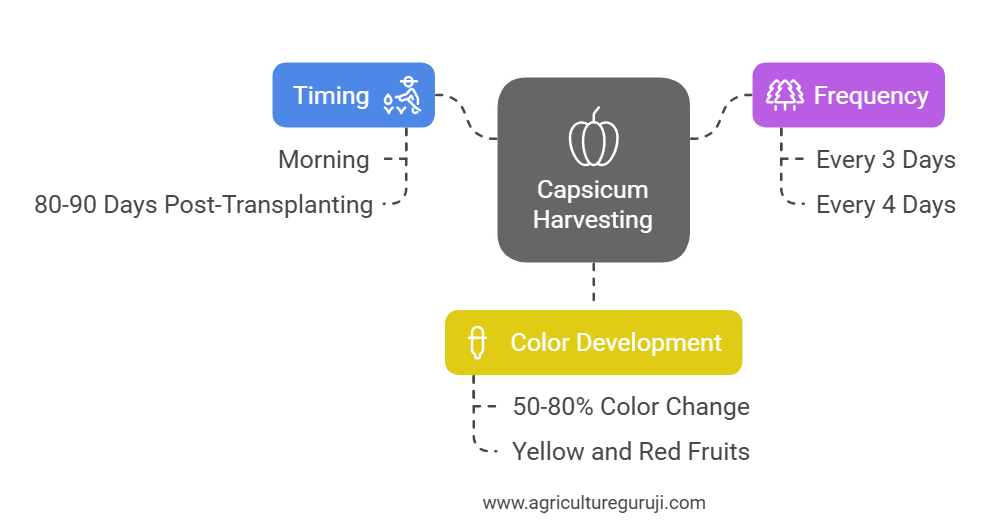
Harvesting of capsicum fruit starts after 80-90 days from transplanting; the best harvesting time is in the morning. Fruits can be cut once in 3 to 4 days. Yellow and red fruits can be harvested when they receive 50-80 percent of the color development.
Disease/ pest in capsicum
Aphids:
nymph and adult suck sap from the plant leaves, resulting in the decreased yield and plant growth.
Thrips:
Thrips cause upper curling of leaves, sucks, and sap from leaf due to which The decrease in the size of the foliage, fruits, and plants, production of fruits reduce and reduce the market value of production.
Whitefly
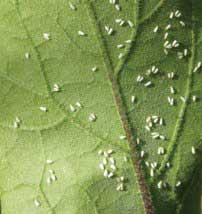
Due to excessive sucking damage (plant juice) and transmitting many viruses.
Fruit Borer:
Fruit borers are very active during the night. They damage fruit & decrease the quality of production.
Nematode:
Stunted growth, Yellowing of leaves, is due to Root-knot nematode. Muddy water During the rainy season is favorable for nematode growth.
Disease
Damping-off:
The transition occurs from the young plants above the ground level, which leads to the disease of seeds and later to die. Planting may occur due to any damage during transplantation.
Powdery mildew:
The disease initially appears on the leaves’ surface as yellowish-brown spots and powder-like material on the lower surface, thereby increasing the powder, which covers the entire surface of the lower surface, which can be dried and dried in later stages drop-offs. This disease reduces the development of leaves and fruits, thereby reducing the quality and quality of production.
cercospora leaf place
Elegantly appears on the leaves’ surface as a yellowish yellow color, which contains sharp dark brown spots, which spread on the entire leaf, resulting in leaves falling.
Phytophthora
During flowering and fruiting, phase Diseases are seen.
Viral Disease:
aphids and thrips transmit Viral diseases.
Cucumber Mosaic Virus (CMV):
Transmission through Aphids due to which Loss of production, low-quality products.
Potato Y Virus (PYV)
Transfer through Aphids due to which leads to the production and quality products.
Tomato spotted wilt virus (TSWV)
Transmission via thrips, Damage: Fruit loss of plant and low production.
Tobacco Mosaic Virus (TMV)
Mechanically infected virus (hand, cloth, device water, soil, etc.)
Reduce production, quality of product decrease.
Capsicum Cultivation Economic:
Capsicum Cultivation Economic in 2008 sq/ meter (20 gunta).
| Particular | Details | Amount |
|---|---|---|
| Area of Polyhouse | 2008 square/meter | |
| Polyhouse Construction | Polyhous as per NHB norms, GI pipe structure & imported plastic @ Rs. 750 / per Sq. mtr. | 1,506,000 |
| Irrigation System | Drip Irrigation system for plants Fertigation unit, Water Filtration unit | 188,000 |
| Bed Preparation | Bed prepared with Red Soil, Rice Husk, FYM, Sand, etc. | 180,000 |
| Plants | Plant Density: 3.75 plants/Sq.Mtr. Total No. of Plants: 7530 Nos. Cost per Plant: Rs.12/plant | 90,360 |
| Total Investment | 1,964,360 | |
| cost of cultivation per year | ||
| Electricity | 3.0 unit/day | 50,000 |
| Water requirement | Approximate per year | 50,000 |
| Fertilizers | Water Soluble Fertilizers | 60,000 |
| Labour | 3- 4 labors per day | 250,000 |
| Crop Protection | Spraying | 60,000 |
| Packing Material Transport, Sales Commission | Packing material, and transport | 162,000 |
| Miscellaneous | Maintenance, Depreciation | 226,800 |
| Subtotal | 858,800 | |
| Returns Per Year | ||
| Yield / Plant / Year | 4 kg | 30,120 |
| Price per Kg | avg price 45 Rs | |
| Total Returns | Per Year | 1,355,400 |
| Cost of Cultivation | Per Year | 858,800 |
| Net Return | Per Year | 496,600 |
Disclaimer: (The above calculations are indicative only.)

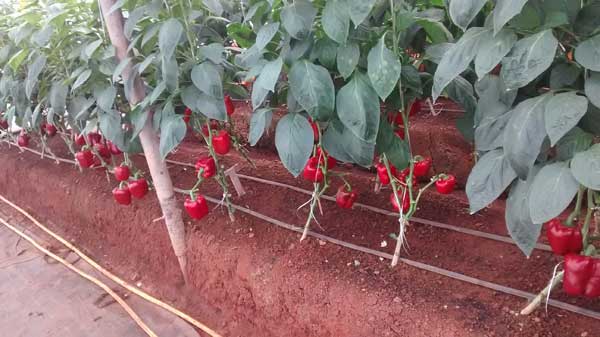


The Labour Cost You Considered is 2.5 Lakhs . i.e for 3 labours a day throughout year one has to pay Rs 228 Per day . Is it a full day work ? because i think you have underestimated the labour cost
Hello Mohit
3 labor required for capsicum 15-20 days in a month and at list one labor is required through the month. average 200 rs cost is considered for one labor.
how many years can we harvest from a single Capsicum plant ? What is the life span of Capsicum plant?
If we harvest capsicum year after year dosen’t it damage the soil or make it infertile ?
Hello Mohit
capsicum, plant lifespan is the 9-12 month
the price / kg =45 .. seems very less ? i mean end consumer buys it for almost 200/kg these days in Pune!! so why to consider it to be so less for the farmer?
Hello Avadhut
45 price is the average price throughout the year. the final price at end customer includes all charges (transportation, commission )
Information provided from your side is very clear and very useful for the farmers.
Thanks, Aaftab
in a one plant of capsicum how much fruits are gro and how much time
Hello Aditya
one capsicum plant produces approximate 4 kg of fruit in one year.
hello.., weight of Each fruit: 80 – 150 gr. Avg. 100 great. 4 Kg = 4000 gr ÷ 100 = 40 Fruits/ plant/ year…..!…..? is it possible….?
Hello D Krishna
You are right capsicum plant produce approximate 4 kg fruit. If you manage properly than capsicum plant produces more than 4 kg of fruit per plant.
After one crop cycle completed in 9 months, would we again errect bed & plant crop? Then it seems more investment recuired again in less then one year (approx. 2-3 lakhs)
Hello
Capsicum is 12-10 month crop. The price of one capsicum plant is low as compared to the gerbera, dutch rose plant, so initial investment required to the plantation is low, but this is continuous cost come at the time of replantation.
Hello Sir..,
Good Day & Greetings for christmas….
This is kousik from Burdwan Westbengal, Im a management professional, now as a newcomer entrepreneur in agriculture field i am starting my career, can you please help me out to give a sample project report about modern CAPSICUM, LETUSH, MANGO & GUAVA FARMING GUIDELINE? i have already procured my a 5 acres of farmhouse for my agricultural project. Expecting your kind considerations
kousik singha roy
Hello Kousik,
You can join our consultancy and training program our team provide complete guidance.to join contact on WhatsApp no. 8788462787
Hi I would like to contact you for project design and cost of polyhouse. We are planning over 16 acres polyhouse near Akola
Hi sir,
please contact us at 8788462787
Hi sir,
I am Prof. B. L. Jadhav and my farm is at Bhokardan, Dist Jalna, Maharashtra.
I have shed net of one acre. I had cultivated capscicum but due to lack of farming knowledge I could get only five harvest and entire crop got diseases. So I had uprooted the crop. Sir will you be giving me a training/consultancy of capscicum farming and other details of it like crop maintenance and marketing etc. How much will be cost of giving of your consultancy. Please inform.
Contact no. 9969145337 & 8369114280
Hello sir,
our team connect shortly, or please call us at 8788462787